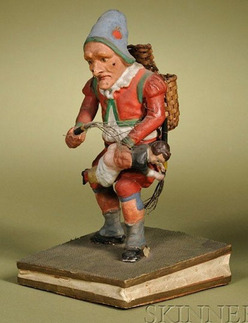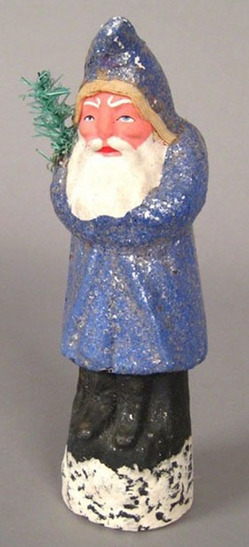Belsnickles
Belsnickle (often spelled in a variety of ways in North America: Belschnickel, Belsnickel, Belznickel, Belznickle, etc., while in German, the spelling is Pelznikel) is the Santa-like figure of the thickly-forested Rhineland region in western Germany known as the Palatinate.
Unlike the modern jovial Santa Claus, Belsnickle is a fearsome figure, more like Krampus in Austria legend, often depicted carrying presents or a Christmas tree in one hand while carrying a bundle of switches in the other. He is normally clad from head to toe in fur (‘Pelznikel’ translates literally as ‘furry Nicholas’), occasionally wearing a long-tongued mask, and distributes coal and switches as freely as candy and gifts. Both his appearance and his potential ‘gifts’ were intended to frighten children into behaving.

A traditional depiction of a Belsnickle punishing a bad child. (p4A item # D9735227)
The Palatinate, located along the borders between France and Germany, was a near-constant battleground for centuries, perhaps beginning with the Nine Years’ War (1689 to 1697), but certainly continuing into the modern day with the post-World War I occupation of the Rhineland. Migration from this region routinely shifting between French and German control was steady, spiking to dramatic levels during times of more intense conflict. The Anabaptists, ancestors of today’s Amish, Mennonites and Hutterites, were especially eager to immigrate, often suffering religious persecution on both sides from the Protestants and Catholics, in addition to the already-tumultuous political climate.
Germans moved to the United States in large numbers as early as the 1680s, and they took their Pelznikel with them, where he took root in the Pennsylvania Dutch communities of the United States. Even today, the Pennsylvania German dialect is mostly a derivative of Palatinate German. (It’s worth noting that Belsnickle traveled almost everywhere the Germans did; even the Volga Germans of Russia, many of whom migrated as late as the 20th century, took the custom with them to their new communities in the United States, Canada and South America.) As Pelznikel evolved, and as Queen Victoria, with her German-born mother, elevated the celebration of Christmas, he became less frightening, transforming into something closer to our Santa, a gentle fur-clad woodsman delivering toys. The word and its meaning morphed as well, becoming “Belsnickle” and coming to mean, in the antiques trade at least, any traditional Santa ornament.

A typical Belsnickle in blue robes. (p4A item # D9728118)
Most collectible Belsnickles take the form of a somber, robed figure, occasionally holding a small Christmas tree in his hand, but normally, all that varies is the color of his robe. Belsnickles appear in robes of almost any color; traditional reds and greens to be sure, but also white, orange, yellow, blue and even pink! Condition is, as always, important, but value of Belsnickle figures is often driven primarily by the rarity of the color of the robe.
Hollie Davis, p4A Senior Editor, December 7, 2009.
